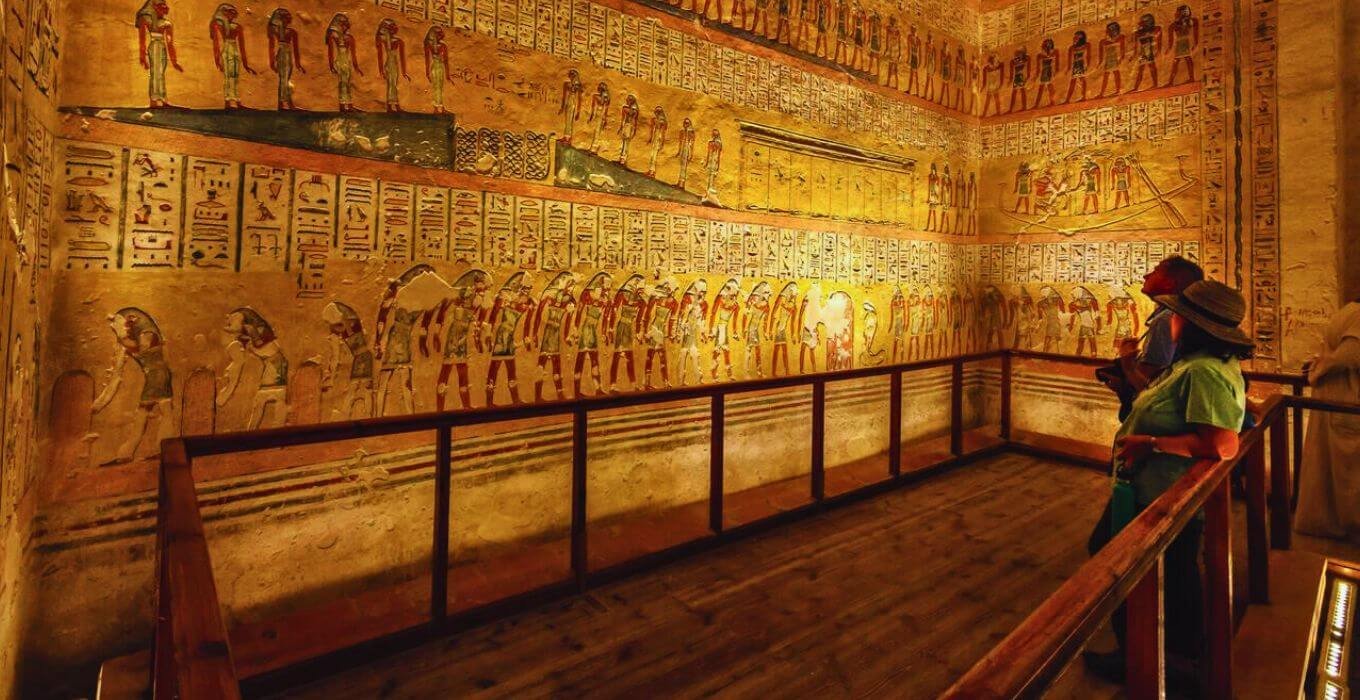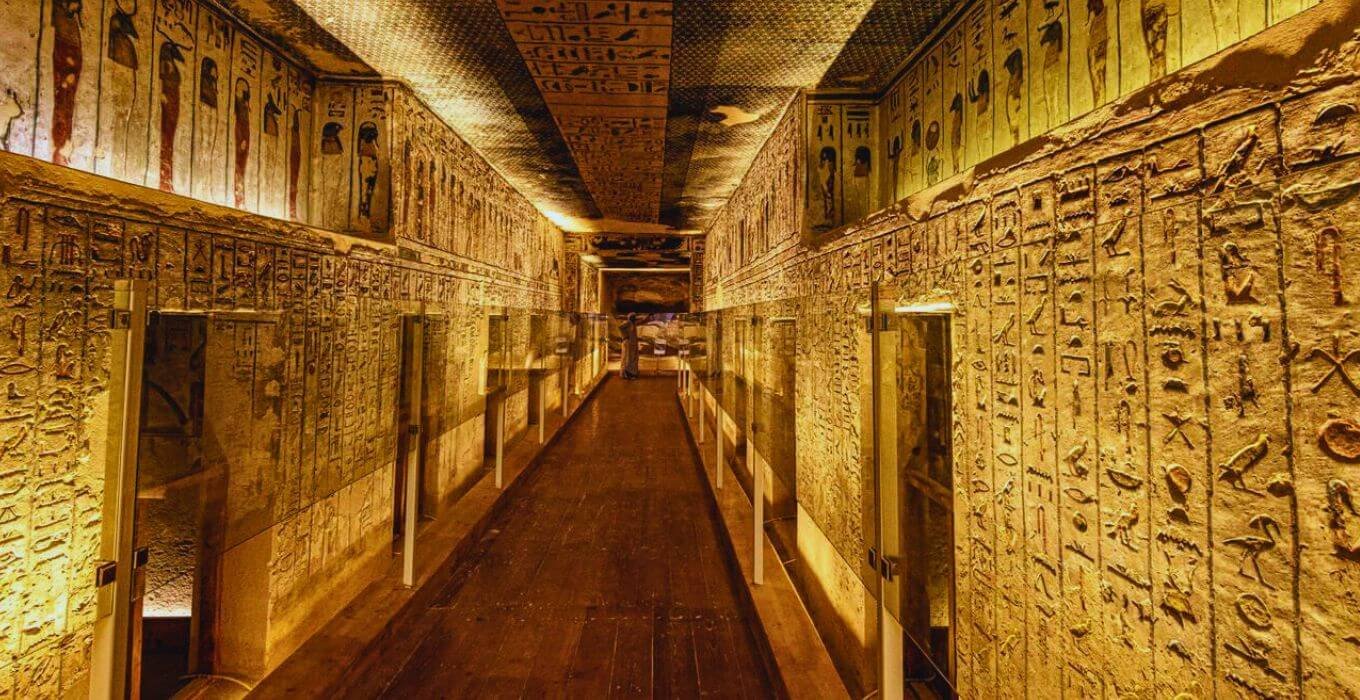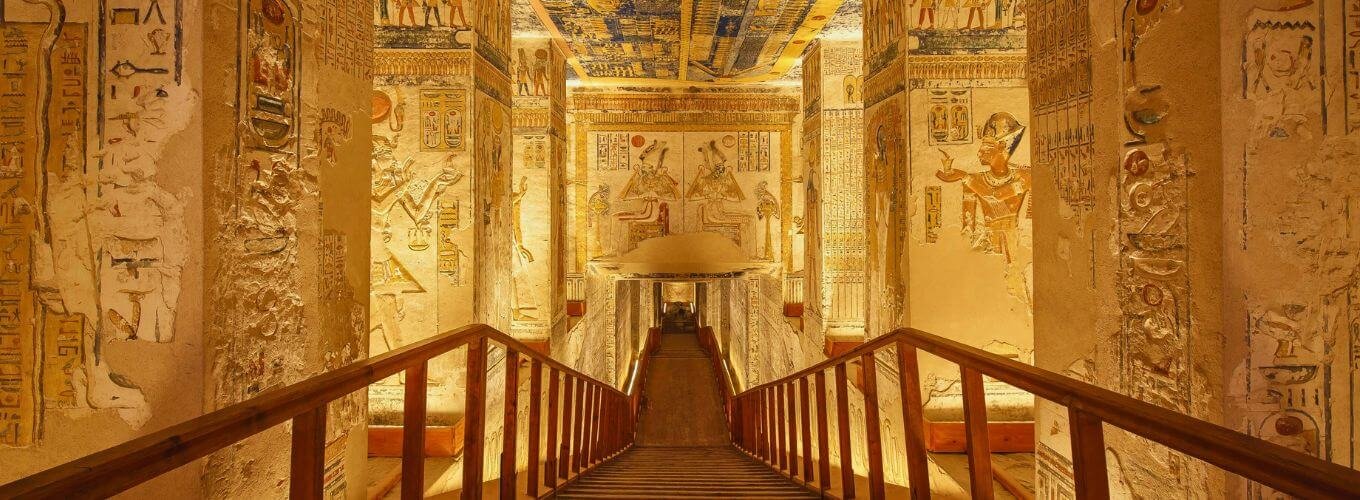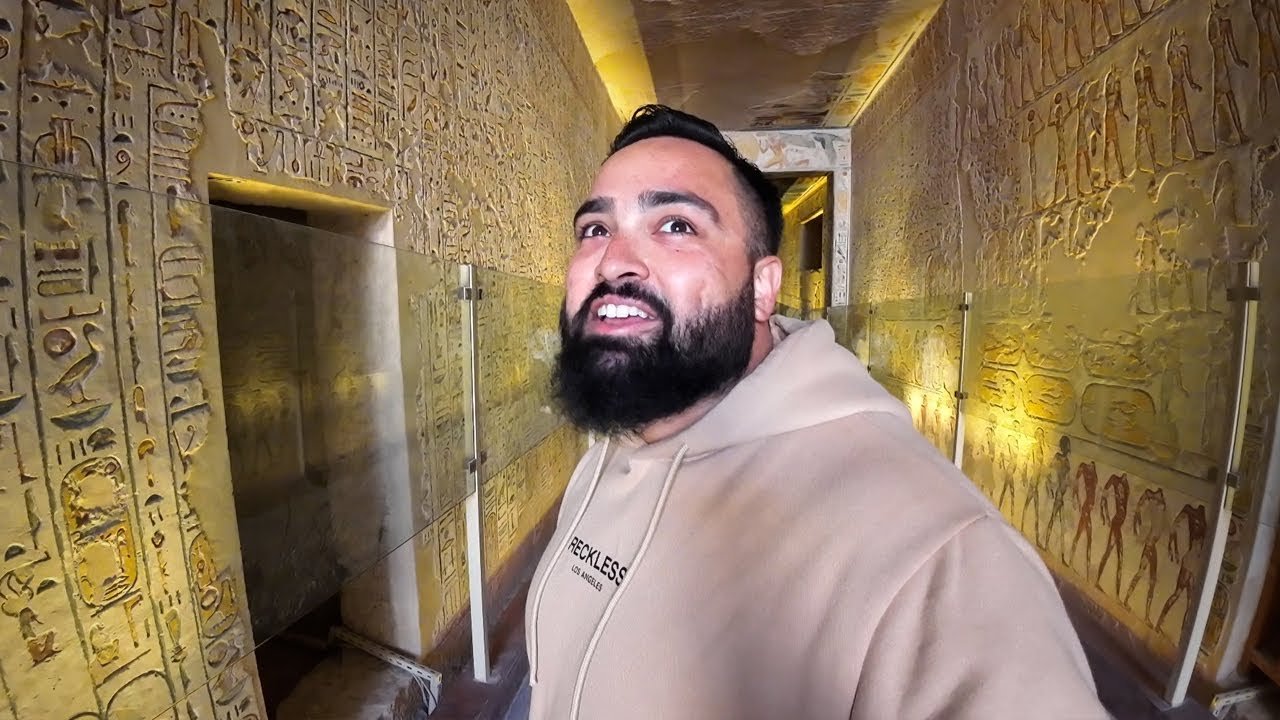Ever wondered what secrets Egypt’s Valley of the Kings holds? This place, near Luxor, is a treasure trove of ancient mysteries. It’s a UNESCO World Heritage Site, a must-see for those who love ancient Egypt.
The Valley of the Kings has fascinated many for centuries. It’s home to over 60 amazing tombs. These tombs were for the pharaohs and nobles of the New Kingdom, from 1539 to 1075 BCE. Each tomb is a masterpiece of architecture, hieroglyphics, and art, giving us a peek into ancient Egyptian life.
Key Takeaways
- The Valley of the Kings served as the burial site for almost all the kings (pharaohs) of the 18th, 19th, and 20th dynasties.
- There are 62 known tombs in the Valley, each showcasing a variety of architectural plans and decorative elements.
- The Valley was designated as a UNESCO World Heritage Site in 1979, recognized for its historical and cultural significance.
- Tutankhamun’s tomb, discovered in 1922, provided an unparalleled glimpse into the wealth and artistry of ancient Egyptian civilization.
- The Valley of the Kings attracts thousands of visitors each day, eager to explore the captivating mysteries of this ancient necropolis.
Unveiling the Majestic Valley of the Kings
The Valley of the Kings is a UNESCO World Heritage Site. It’s located on the west bank of the Nile River, near Thebes. This place was the final resting spot for many pharaohs and nobles during ancient Egypt’s New Kingdom period, from about 1550-1070 BCE.

A UNESCO World Heritage Site Steeped in History
The Valley of the Kings became famous as a royal burial site during Thutmose I’s reign. He chose this spot to keep tombs safe from grave robbers. Over five centuries, it housed many pharaohs and nobles, including Tutankhamun and Ramses II.
Home to Iconic Tombs of Pharaohs and Nobles
So far, archaeologists have found 63 tombs in the Valley of the Kings. Each one gives us a peek into the lavish burial customs of ancient Egyptian royalty. The discovery of Tutankhamun’s tomb in 1922, with its treasures, has amazed the world and enriched our understanding of this site.
“The Valley of the Kings is a true testament to the grandeur and ingenuity of ancient Egyptian civilization, where the final resting places of pharaohs and nobles have been preserved for centuries.”
The Valley of the Kings still fascinates visitors from all over. It offers a direct link to the legendary rulers and the advanced culture of the Nile.
Exploring the Tombs of Ancient Rulers
The Valley of the Kings in Egypt is famous for its royal tombs with hieroglyphics and stories of pharaohs’ afterlife journeys. These tombs show the deep ancient Egyptian beliefs and funerary practices that have amazed people for ages.
Intricate Decorations and Hieroglyphics Adorn the Walls
There are 63 tombs in the Valley of the Kings. They belong to pharaohs, their sons, and important officials. It took about 70 days to mummify each person during the New Kingdom period.
Only one tomb in the Valley of the Kings is still untouched, except for one famous case. The walls of these royal tombs have detailed paintings and hieroglyphic writings. They tell us a lot about the lives and beliefs of ancient Egyptian rulers.
These tombs show the deceased with gods, funerary texts, and stories of their afterlife journey. They give us a glimpse into the culture and religion of this amazing civilization.
|
Tomb |
Ruler |
Reign |
Key Facts |
|
KV9 |
Ramesses V |
1147-1143 BCE |
Reigned for a brief period of four years and was the first documented case of smallpox; thereafter, his paternal uncle Ramesses VI reigned for the next 8 years. |
|
KV6 |
Ramesses IX |
1126-1108 BCE |
His reign is most known for the tomb robbery trials recorded in the Abbott Papyrus. |
|
KV13 |
Merenebetah |
Unknown |
Ramesses II’s 13th son, his tomb is the second-largest in the Valley of the Kings, featuring Greek and Coptic graffiti. |
Valley of the Kings: A Glimpse into Ancient Egyptian Life
Visiting the tombs in the Valley of the Kings offers a deep dive into ancient Egyptian culture. The detailed artwork and hieroglyphics on the walls share stories of the rulers. They also give insights into daily life, religious ceremonies, and mythology of the Egyptians.
The Valley of the Kings is home to famous tombs like Tutankhamun’s. It also has the tomb of Seti I, known for its stunning decorations. These tombs show scenes of everyday activities and mythological depictions. They give a full view of the ancient Egyptian beliefs and practices.
“The Valley of the Kings was the primary burial location for Egyptian royalty for over 500 years, from 1539 to 1075 BC.”
The tomb of Ramses VI is a highlight, with its detailed astronomical ceilings and afterlife scenes. It shows how important religious ceremonies and mythology were to the Egyptians. The Valley of the Queens, next to the Valley of the Kings, is where queens and royal children were buried. It highlights the value of family and the royal dynasty.
Guided tours are a must to fully enjoy the Valley of the Kings. They offer a deeper understanding of ancient Egyptian culture. This way, visitors can dive into the rich history preserved in the Valley of the Kings.
The Architectural Marvel of the Tombs
The tombs in the Valley of the Kings are amazing examples of ancient Egyptian architecture and engineering. Each tomb had a special layout with corridors, shafts, and big burial chambers. The walls were covered in detailed carvings, paintings, and hieroglyphs, showing the builders’ incredible artistry and skill.
The grand design and detail in these tombs show the ancient Egyptians’ ingenuity and craftsmanship. They used stone for tombs and temples, and mud brick for homes. Egypt’s mortuary architecture was very advanced, with big tombs and funerary chambers for offerings.
Stunning Artistry and Craftsmanship on Display
The tomb of Seti I, from the 19th dynasty, went 328 feet into the mountain. It had a burial chamber with a barrel-shaped roof, symbolizing the sky. The decorations, colorful reliefs, and carvings on the walls of this tomb and others, like the tomb of Ramses II, give us a peek into ancient Egyptian history and art.
“The Valley of the Kings offers a glimpse into the remarkable architectural and artistic achievements of ancient Egypt.”
There are over 60 royal tombs and chambers in the Valley of the Kings. Famous ones include those of Tutankhamun, Ramses II, and Seti I. The tomb of Tutankhamun (KV62), found in 1922 by Howard Carter, is famous for its treasures, like the golden mask of Tutankhamun.
Discovering Tutankhamun’s Treasured Tomb
The Valley of the Kings is famous for its amazing discoveries. But none is more exciting than the 1922 find of Tutankhamun’s tomb by Howard Carter. This event amazed the world and gave us a peek into the life of the young pharaoh from the 14th century BCE.
Howard Carter’s Remarkable 1922 Discovery
On November 26, 1922, Carter and his team found Tutankhamun’s tomb. It was almost fully intact. The tomb had four chambers filled with over 5,400 items. These included Tutankhamun’s personal things, jewelry, furniture, and gold chariots.
The process of clearing the tomb took ten years. Harry Burton, the expedition photographer, took over 1,800 photos. This helped document the treasures found.
The discovery of Tutankhamun’s tomb was a big deal in Egyptology. It gave us a rare look into ancient Egyptian beliefs, culture, and burial customs. The tomb was mostly untouched, offering a unique chance to study the king’s mummification and burial after his death in 1323 BCE.
“The tomb was virtually intact, a treasure trove of ancient Egyptian artifacts and a window into the life of a long-forgotten pharaoh.”
The Treasures of Tutankhamun exhibition was a huge hit, attracting eight million visitors. It showed the power of blockbuster exhibitions.
|
Discovery Fact |
Details |
|
Date of the opening of Tutankhamun’s tomb |
November 26, 1922 |
|
Number of objects found in the antechamber |
more than 600 items |
|
Time spent removing and cataloging items in the antechamber |
over two months |
|
Number of rooms inside the tomb |
the antechamber, burial chamber, treasury, and annex |
|
Total number of objects removed from the tomb by Howard Carter |
more than 5,000 |
|
Time duration of Carter’s excavation work in the tomb |
nearly 10 years |
|
Number of shrines found in the burial chamber |
three |
|
Number of golden coffins found inside the burial chamber |
three |
|
Number of items found in the annex |
over 2,000 items |
|
Howard Carter’s lifespan after opening the tomb |
another 17 years |
Planning Your Visit to the Valley of the Kings
The Valley of the Kings is a key spot in Luxor, Egypt. It’s open every day, except Fridays, from 8 am to 4 pm. This UNESCO World Heritage site lets you see the history of Egypt’s pharaohs up close.
Best Time to Explore the Ancient Wonders
The best times to visit the Valley of the Kings are spring (March-May) and autumn (September-November). The weather is nice and not too hot. You’ll avoid the big crowds and heat of summer.
There are many guided tours to choose from. They give deep insights into the site’s history. Remember to dress modestly, covering your arms and legs, to respect local customs.
Tickets for the Valley of the Kings have different prices. The main ticket is 600 EGP per person. Tram tickets are 20 EGP for a round trip. Extra tombs, like Tutankhamun’s, cost more.
The Luxor Pass is great for those visiting Luxor for a few days. It costs $130 USD for adults and $70 USD for students under 30. The Premium Pass, with more sites, is $250 USD for adults and $130 USD for students.
Whether you love history or just want to see something amazing, the Valley of the Kings is unforgettable. It takes you back to ancient Egypt’s golden age.

Activities and Adventures in the Valley
The Valley of the Kings in Luxor, Egypt, is more than just tombs. It offers exciting activities and adventures. You can join guided tours, go on camel rides, or take hot air balloon flights. Each way lets you explore this UNESCO World Heritage site in a unique way.
Guided Tours and Camel Rides
Guided tours introduce you to the Valley of the Kings. You’ll learn about its history and the tombs’ decorations. Guides share stories that make the ancient past come alive.
For something different, try camel rides. They let you see the desert landscape like ancient Egyptians did. It’s a fun way to explore.
Soaring High in Hot Air Balloons
Hot air balloon rides are a highlight in the Valley of the Kings. They give you amazing views of the valley, the Nile, and Luxor’s landmarks. It’s a chance to see the site’s grandeur from above.
Whether you’re on a guided tour, camel ride, or hot air balloon, there’s always something new to discover. The Valley of the Kings in Luxor, Egypt, is a place of adventure and history. It promises an unforgettable experience.
The Valley of the Kings: A Journey Through Time
The Valley of the Kings is a window into the ancient Egyptian civilization. It’s filled with amazing tombs, detailed artwork, and a rich history. Visitors can travel back in time and learn about the pharaohs and their people.
Exploring the Valley of the Kings is like stepping into another world. It’s not just about history; it’s about the culture and heritage of Egypt. It’s a journey that sparks curiosity and deepens appreciation for the past.
At the heart of this ancient place are over 60 tombs. Each one is a doorway to the ancient Egyptian world. The tomb of Tutankhamun and Ramses VI’s tomb are just a few highlights.
The discovery of Tutankhamun’s tomb in 1922 was a major breakthrough. It revealed treasures that still amaze people today. Scholars and the public are drawn to these artifacts.
The Valley of the Kings is just 6 kilometers from Luxor. It’s a place where the past meets the present. Whether you love history, adventure, or just want to explore, the Valley of the Kings is unforgettable.
Read other related articles:

